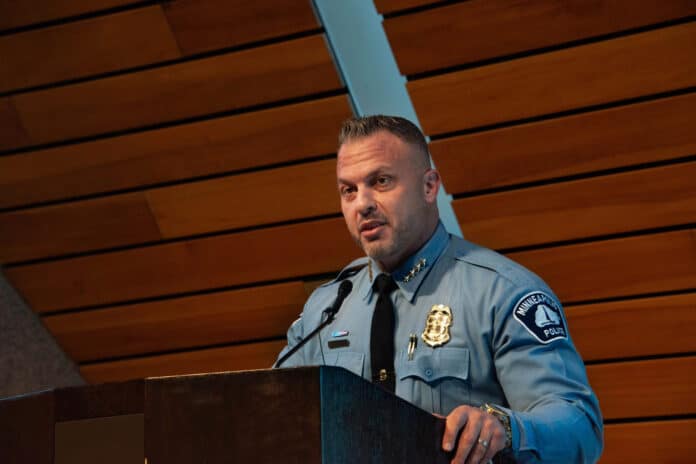
In a panel convened for the April edition of Harper’s Magazine, Minneapolis Police Chief Brian O’Hara joined a discussion about the state of policing in America with several law professors and academics, as well as Ras Baraka, the current mayor of Newark, N.J.
The panel was convened to discuss developments in police reform since the death of George Floyd in May of 2020. The group explored the subsequent effects of those reforms on police staffing and recruitment, as well as crime rates around the country, in the years since. Chief O’Hara and Mayor Baraka were invited for their real-world experience and because they’ve both been “credited with reducing violent crime in their cities.”
The panel opened by discussing political ideologies around crime and policing. Chief O’Hara said that after a year running the Minneapolis Police Department, he’s “still shocked by how extreme these ideologies are.” He explained that “for some folks, hating the police has become a political cause,” noting that “there’s still a very strong movement to defund the police, even in the middle of a five-alarm fire.” He pointed out that in the context of a surge in crime since 2020, the MPD is 40 percent smaller than it was that year.
In response, panelist Christy E. Lopez, a professor at Georgetown Law, asked Chief O’Hara how he makes sense of the fact that the number of homicides went down in Minneapolis from 2022 to 2023, despite having far fewer officers. The chief said that this is the result of the police “being incredibly precise” and “going after the people who are causing the most serious harm to the community.”
For example, he noted that in 2023, state and federal agencies used the Racketeer Influenced and Corrupt Organizations (RICO) Act for the first time in the history of the state to prosecute gang members dealing fentanyl and were able to “very efficiently dismantle a fentanyl-trafficking ring,” an action which on its own “had a significant impact on violence.”
Professor Lopez asked if that doesn’t prove “that we can make do with fewer police officers and shift some of those resources to a broader public-safety response?”
“No. The situation is not sustainable,” Chief O’Hara replied, later describing the city as “insanely violent with guns right now.” Although homicides decreased from 80 to 72 between 2022 and 2023, that figure is still much higher than the 48 homicides reported in 2019.
O’Hara said that while MPD staffing is down 40 percent overall, these staffing shortages have different effects within different units.
For instance, he noted that the “investigations unit has shrunk by almost 50 percent,” which means that Minneapolis police “might soon be in a situation where we’re just not going to investigate property crimes anymore.” If that happens, “the community that will suffer the most is North Minneapolis.”
“On my first visit there after becoming chief, it felt like New York City on September 12, 2001. People really, really want police protection. They just want good police officers. But then you have wealthier residents on the other side of town who are still screaming to get rid of us, even though the most that happens in their neighborhoods is change getting stolen out of their cars,” he said.
Patrick Sharkey, a professor of sociology and public affairs at Princeton University, said that the people on that side of town have a “clear misconception that police aren’t effective,” when in fact “we have strong evidence in the social sciences indicating that when you have more police officers on the street, it reduces violent crime.”
“There’s just no way to argue that claim,” he said. Another panelist noted that “they think violent crime is just some right-wing myth.”
Later in the discussion, Chief O’Hara talked about some of the challenges the police department faces when trying to coordinate social services provided by other government agencies in order to help citizens and prevent violence. He explained that “one issue is that no one is able to share information between all these different systems that should be working together.”
As an example, he told the story of a woman from a Minneapolis suburb who was a victim of domestic violence and had “moved into the city so she could live in a homeless shelter.” She has a nine-year-old son who’s autistic and often runs away. Over time, “[MPD] had 10 or 12 interactions with him” and he “has become increasingly violent.” In their last interaction, he tried to stab a police officer, but Chief O’Hara said “no one was hurt.”
“We have social workers in the precincts who work for Hennepin County, and the county is supposed to provide all this help and everything else. Even after I got involved personally, it still took weeks to get some help. It’s crazy how bad the rest of the system is,” he commented. “It’s a crisis. It is an emergency. Could you imagine if we shot an autistic child trying to stab a cop? We can’t get help in these situations. I think people just don’t understand how dysfunctional the rest of the system is.”
According to Harper’s, the panel convened in person in November 2023 and then continued the discussion via email.
Shane Hachey
Shane Hachey is a journalist and blogger based in the Twin Cities. He covers national politics, race, and local issues. Prior to that, he studied history at Columbia and law at Harvard Law School, and he was an Army Military Policeman for five years stationed in Germany, Yugoslavia, and Fort Hood, Texas.









